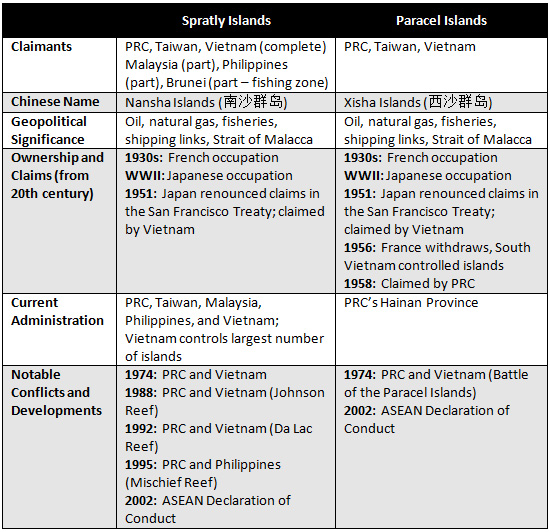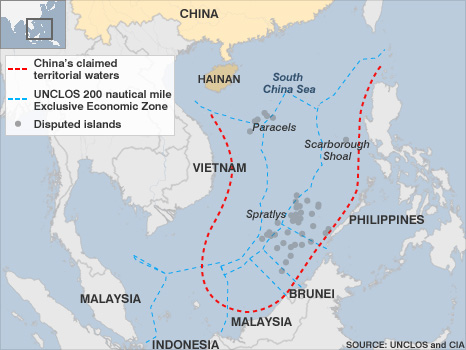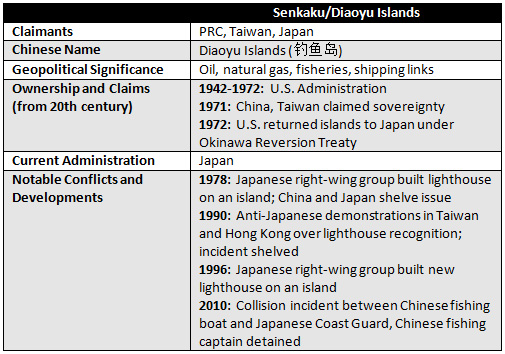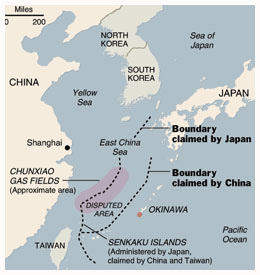China’s Territorial Disputes in the South China Sea and East China Sea
By Shelly Zhao
May 31 – Territorial issues in the South China Sea (SCS) and East China Sea (ECS) have gained more attention recently, prompting questions about China’s intentions in the region. Why are these territorial disputes significant, and what are the prospects for future cooperation? Both the SCS and ECS are geopolitically significant and represent an intersection of history, sovereignty and territory, geostrategy, and energy security, impacting China’s relations with its neighbors. This article looks at three major territorial disputes in China’s surrounding waters and discusses the concerns for regional cooperation and stability.
Territorial and maritime sovereignty
Two main areas of dispute are important for distinction: territorial sovereignty and maritime sovereignty. Territorial sovereignty disputes concern claims of rightful ownership of the land itself and usually refers to historical presence in determining rightful control. Maritime boundary disputes relate to the territorial delimitations allowed by the 1982 United Nations Convention on the Law of the Sea (UNCLOS III).
UNCLOS specified a 12 nautical mile territorial sovereignty boundary from a nation’s coastline, as well as a 200 nautical mile creation of exclusive economic zones (EEZs), which includes the seabed resources within that sphere from the shoreline. This is significant because the country who has sovereignty over the islands would also own the natural resources in the surrounding area. The untapped oil and gas deposits surrounding the islands make them geopolitically significant.
South China Sea: Spratly Islands and Paracel Islands
Two major territorial disputes in the South China Sea are the Spratly Islands and the Paracel Islands. The remaining South China Sea disputes are the Macclesfield Bank (PRC, Taiwan, and Philippines), the Scarborough Shoal (PRC, Taiwan, and the Philippines), and Pratas Island (PRC and Taiwan). The table below gives an overview of the Spratly and Paracel territorial conflicts in brief:

Spratly Islands
Located south of China, southeast of Vietnam, west of the Philippines, and north of Malaysia, the Spratly Islands have been disputed among several countries since 1988. There have been a number of confrontations and China has clashed with both Vietnam and the Philippines over the region. A turning point occurred with the 1995 Mischief Reef incident where China’s PLA Navy built an installation on Mischief Reef, resulting in a confrontation between China and the Philippines. To China’s surprise, ASEAN gave a united condemnation of their actions. In the past decade, the Spratly Islands conflict has become more institutionalized into ASEAN.
Paracel Islands
Located east of Vietnam and south of China’s island province of Hainan, the Paracel Islands have seen less confrontation than the Spratly Islands, though Vietnam still contests China’s administration today. After the 1974 Battle of the Paracel Islands between naval forces of China and then-South Vietnam, which resulted in the death of 18, China defeated Vietnam and has controlled the islands to this day. In 2002, ASEAN countries put forth a Declaration of Conduct for both SCS disputes, putting forth a (non-binding) agreement to operate under ASEAN core principles.

East China Sea: Senkaku/Diaoyu Islands
The Senkaku/Diaoyu Islands dispute between China, Taiwan, and Japan has seen occasional flare-ups over the last few decades that have led to bilateral tensions. Located east of China, northeast of Taiwan, and southwest of Japan, the main conflicts that have occurred in the area have been between China and Japan over sovereignty as well as EEZ delimitation.

In the SCS, China has claimed a “U-shaped line” of demarcation for its EEZ and continental shelf for decades and, in 1992, China’s National People’s Congress passed the Law on the Territorial Sea and Contiguous Zone. This law specified that the SCS and ECS islands fell under China’s geographic scope as well as authorized the PLA to evict intruders, such other states’ naval vessels, from the territory. China has continued to reiterate its sovereignty claims to the SCS and ECS islands, stressing that they are “indisputable.”

Regional developments in 2010 and 2011
In spite of previous efforts to institutionalize the territorial disputes, the SCS and ECS have remained key waters for countries wishing to gain or preserve geopolitical influence in the region. In the past year, recent developments and some actions have led observers to question China’s role in the area and the likelihood of its peaceful rise, particularly as the reasoning and priorities can be opaque, leading to uncertainties about Chinese intentions.
Some of the more notable recent developments in 2010 and 2011 include:
- March 26, 2010: North Korea reportedly sank the South Korean ship Cheonan in the Yellow Sea, and China questioned the findings of the independent investigation and did not condemn North Korea.
- July 2010: Secretary of State Hillary Clinton said at the ASEAN Regional Forum that the U.S. supported multilateral resolution and “oppose[d] the use or threat of force by any claimant” in the South China Sea. Chinese Foreign Minister Yang Jiechi responded that China had “indisputable sovereignty” in the South China Sea. China reportedly said that it considered the SCS to be within its core interests, though whether or not this actually occurred has been debated – for example, Wang Jisi noted in 2011 that Chinese commentators’ references to the SCS as a core interest were “reckless statements, made with no official authorization.”
- September 7, 2010: The Chinese fishing boat Minjinyu 5179 collided with two Japanese vessels near the Senkaku/Diaoyu Islands resulting in the detention of the fishing boat’s captain. Western media reported that China issued a ban on rare earth exports to Japan as a result, though China denied this.
- September 11, 2010: Chinese vessels apprehended Vietnamese fishing vessels in waters near the Paracel Islands.
- October 27, 2010: China launched new marine patrol vessels to patrol the SCS.
- November 23, 2010: North Korean forces shelled Yeonpeong Island near a disputed border area with South Korea. China expressed concern but did not condemn North Korea.
- December 17, 2010: Japan released its 10-year defense guidelines (White Paper) which listed North Korea, Russia, and China as regional concerns, suggesting a more security-oriented defense posture.
- March 2, 2011: The Philippines protested against two Chinese patrol boats that confronted a Philippine vessel in Reed Bank near the Spratly Islands. The Philippines sent two aircraft and filed a protest with the United Nations in response.
- March 3, 2011: Japan sent jets after seeing Chinese planes near the Senkaku/Diaoyu Islands.
- May 29, 2011: Vietnam protested Chinese maritime vessels’ violation of sovereignty in its claimed EEZ.
Potential for cooperation in the SCS and ECS
How have observers reacted to China’s actions? Some feel its actions are harmful for regional stability and, in the long term, they put China’s “responsible power” image in question. China’s assertive attitude accompanied by its military modernization seems to have only confirmed fears of China’s destabilizing rise.
“Frankly, it’s not good news for the neighborhood and the question is whether the top [Chinese] leaders will take a look at the results they’re getting and say, on balance, we had better recalibrate,” Kenneth Lieberthal, director of the John L. Thornton China Center and senior fellow in Foreign Policy at the Brookings Institution, told Bloomberg in September 2010.
A report in The Economist around the same time said that the Chinese leadership’s strong response in 2010 “has harmed China ultimately, undermining confidence in China as a responsible stakeholder in the region.”
International relations expert Joseph Nye also said in December last year that the region was “very much scared about China,” which in turn makes a continued U.S. presence more reassuring for neighboring countries.
The analyses above point to important security considerations about how a rising power will impact geopolitically-significant areas. In the SCS, the Spratly Islands appear to have more potential for conflict than the Paracel Islands, and in the ECS, the Senkaku/Diaoyu Islands incidents have been episodic, but potentially volatile over the decades. Yet more tempered and balanced rather than fear-driven perspectives, and focus on common and long-term interests rather than extracting short-term gains, may be more beneficial for moving ahead.
In the SCS and ECS territorial disputes, there have not been fundamental resolutions of territorial sovereignty nor maritime boundary delimitations acceptable to the parties involved. The competing sovereignty claims result from fundamentally differing perspectives on historical right to ownership, making convergence and reconciliation of the conflicting views tough to achieve.
Central to the territorial disputes are the potentially rich natural resources in the claimed EEZs, and in terms of maritime delimitation, scholars such as Mark J. Valencia and Unryu Suganuma have pointed out that joint resource development can help build cooperative frameworks between the claimants, potentially leading to a more institutionalized method of energy resource distribution for the long-term.
Moving forward with resource cooperation where China does not have administration of some disputed islands (in the Spratly Islands and Senkaku/Diaoyu Islands, for example) can also be a practical option of advancing the status quo without connoting the acceptance of the other party’s sovereignty claims. Deng Xiaoping saw the “shelving” (gezhi) policy of cooperation practical for mutual economic gains, while not at the expense of yielding claims to sovereignty, which China sees as indisputable. In the Senkaku/Diaoyu dispute, there have been some strides in bilateral resource development, examples including a fisheries agreement signed in 1997 and an agreement to develop the Shirakaba/Chunxiao oil field in 2008. Focusing energies on longer-term joint development initiatives will likely be most practical as well as beneficial for building trust and promoting positive-sum gains.
In the near future, countries in Southeast Asia are likely to favor regional engagement from powers such as the United States and Japan for security. For all claimants involved, rebuilding trust and giving reassurance in bilateral relationships, matched in words and in action, will be important in overcoming “suspicion begetting suspicion” and “fear begetting fear” cycles. Because of their geopolitical significance, moving toward formalizing joint development frameworks will be extremely important for the SCS and ECS islands, and a key determinant for prospects of cooperation.
Related Reading
Russia’s Vladivostok to Boom as China Cuts Mineral Exports
China’s Tibet Price: the South China Sea
- Previous Article Mongolia Connects to Hong Kong with Direct Flights and Consulate
- Next Article Doing Business in East China: A Guide for Indian Companies and Entrepreneurs




























